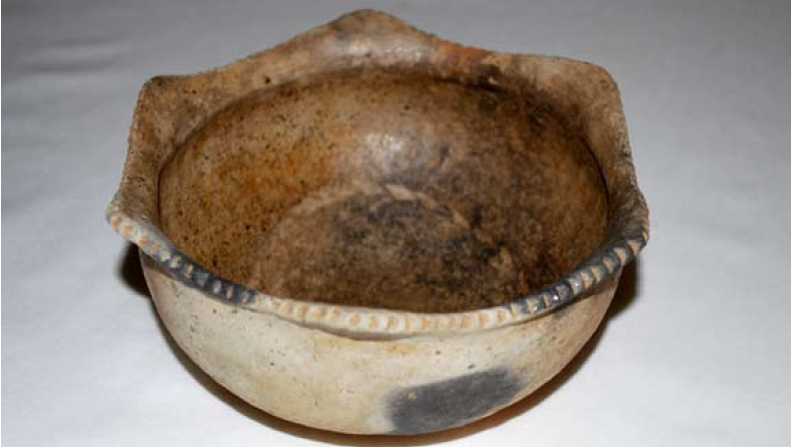|
Tempering in Southern Pottery |
by Bruce Butts, Winterville, |
| Central States Archaeological Societies 2013
July Journal |
Georgia |
|
|
| top: Two examples of a five sided “star” vessel from
the southeast. |
Native American ceramics first appeared in the Southeastern United States in
the middle Savannah River Region in Georgia and South Carolina (known as Stallings,
Stallings Island, or St. Simons) and have been dated to about 4400 BP. Fiber-tempered
potsherds found at Rabbit Mount near the lower Savannah River in South Carolina
have been dated to 4465 ±95 and 4450 ±150 radiocarbon years
before present. We will never know who was the first person to learn that
mixing certain materials (tempering) with ordinary clay caused the clay pot
to hold together better and make a tougher pot but it was without doubt a
major discovery and advancement in making fired clay pottery.
Ceramics of these cultures in northern Florida and around the coast toward
Stallings Island all appear around 4400 BP and are all older than any other
dated ceramics from north of Colombia, Brazil. Ceramics appeared later elsewhere
in North America reaching southern Florida (Mount Elizabeth) by 4000 BP,
Nebo Hill (in Missouri) by 3700 BP, and Poverty Point (in Louisiana) by 3400
BP. Two major pottery types appeared in the eastern United States.
Hopewell pottery is the ceramic tradition of the various local cultures
involved in the Hopewell tradition (ca. 200 BC to 400 AD)[28] and are found
as artifacts in archeological sites in the American Midwest and Southeast
Mississippian culture pottery is the ceramic tradition of the Mississippian
culture (800–1600 AD) found as artifacts in archaeological sites in
the American Midwest and Southeast.
Not all Native American pottery requires added tempers; some Hopi potters
use pure kaolin clay that does not require tempering. Some clays naturally
contain enough temper that they do not required additional tempers. This
includes mica or sand in clays used in some Taos Pueblo, Picuris Pueblo,
and Hopi pottery.
Ceramics are sometimes used to identify certain cultures. The type of temper
(or mix of tempers) used helps to determine the ceramics produced by different
cultures during a particular time period. Crushed bone was used as temper
in at least some ceramics at anumber of sites in Texas. In the Southeastern
United States, the earliest ceramics were tempered with fiber such as Spanish
moss and palmetto leaves. In Louisiana, fiber was replaced first by grog
and later by shell. In the peninsular Florida and coastal Georgia sand replaced
fiber as tempering. Still later, freshwater sponge spicules became an important
temper in the "chalky ware" of the St. Johns culture in northeastern
Florida. The choice of temper used in ceramics had a lot to do with what
was available, but changes in the choice of temper can provide clues to influence
and trade relations between groups. Shell-tempered ware was produced sporadically
in various places across the eastern United States, but in the late Woodland
and early Mississippian periods it became the predominant temper used across
much of the Mississippi Valley and middle gulf coast, and a major defining
characteristic of Mississippian culture pottery. It would be very rare that
you would find a Mississippian pottery vessel that was not tempered with
shell in the state of TN. Again it comes down to a point of what was available.
Tenn. has many rivers that crisscross the stateand thus there was plenty
of shell to use as tempering.
This brings us to the point of writing this lesson of history and the fact
that early Native Americans used what was the most available material that
they had for resources. I have two pictures (Fig. 1 & Fig. 2) of a somewhat
rare type of pottery vessell, the form being a low shallow bowl with five
points sticking out making a star. One is from the Lewis Farm Site sometimes
called The Porch Site, found on the Coosawattie River in Gordon County,Georgia,
and one is from near the Hiwassee Island in Miegs County,Tennessee. Hiwassee
Island has been a well-used site and is actually where two Tennessee rivers
come together; The Tennessee River and The Hiwassee River. Their distance
apart for the two sites “as the crow flies” is only 30 miles,
but they are fed by different river systems and so one is made with sand
tempering and the other is made with shell tempering. One maker had plenty
of ground shell and the other had plenty of fine sand.
Can you pick the difference to know which came from Georgia or Tennessee?
|
|
| Figure 1.This example shows the use of shell as the tempering agent
and the shell is quite visible over the entire pot, causing it to be somewhat rough. Collection of the Author. |
| |
 |
| Fig. 2 This example shows the smoothness of the pottery from using
fine sand as a tempering agent. The inside of the bowl has such a glossy surface. Collection of the Author |
References:
Forman, Mary Douglass & Fundaburk, Emma Lila
1957 Sun Circles and Human Hands The Southeastern Indians Art and Industry
Southern Publications
Milanich, Jerald T.
1994 Archaeology of Pre-Columbian Florida University Press of Florida
Walthall, John A.
1980 Prehistoric Indians of the Southeast: Archaeology of Alabama and
the Middle
South The University of Alabama Press.
Weinstein, Richard A. & Dumas, Ashley A.
" The Spread of Shell-tempered Ceramics along the Northern coast of the
Gulf of Mexico". Southeastern Archaeology 27(2): 202–221 |
Authors note:
The shell temper comes from The Tennessee River and The Hiwassee
River area around Hiawassee Island in Meigs County. Tennessee. The sand temper comes from near
the Coosawattie River, an area named The
Lewis Farm Site or The Porch Site in Gordon County,
Georgia.
*****If you are still guessing, Figure 1. is from Tennessee and Figure 2. is from Georgia.
|
|
|




